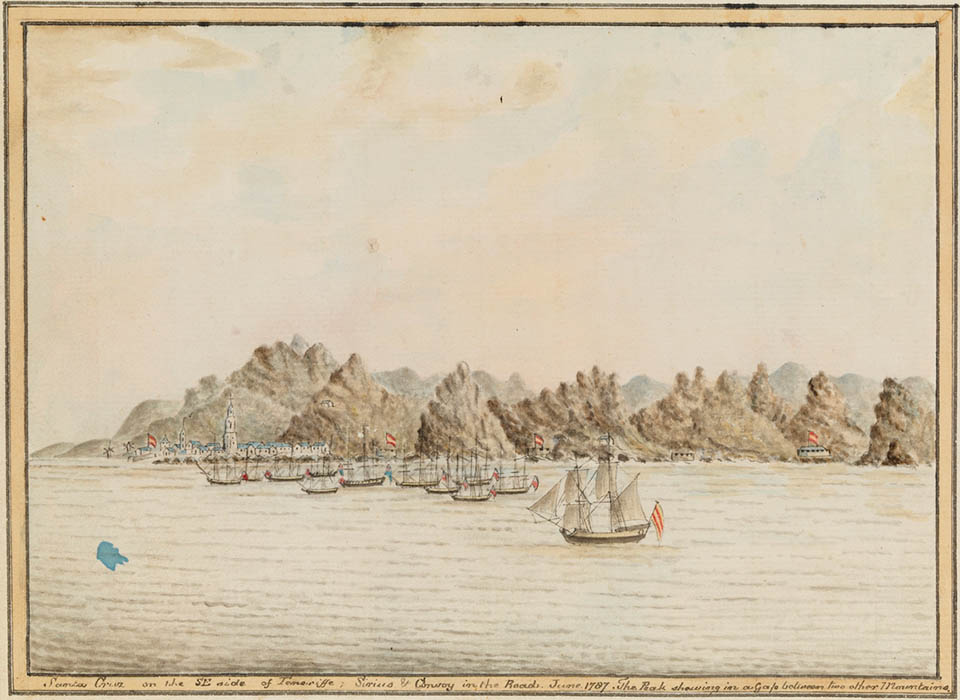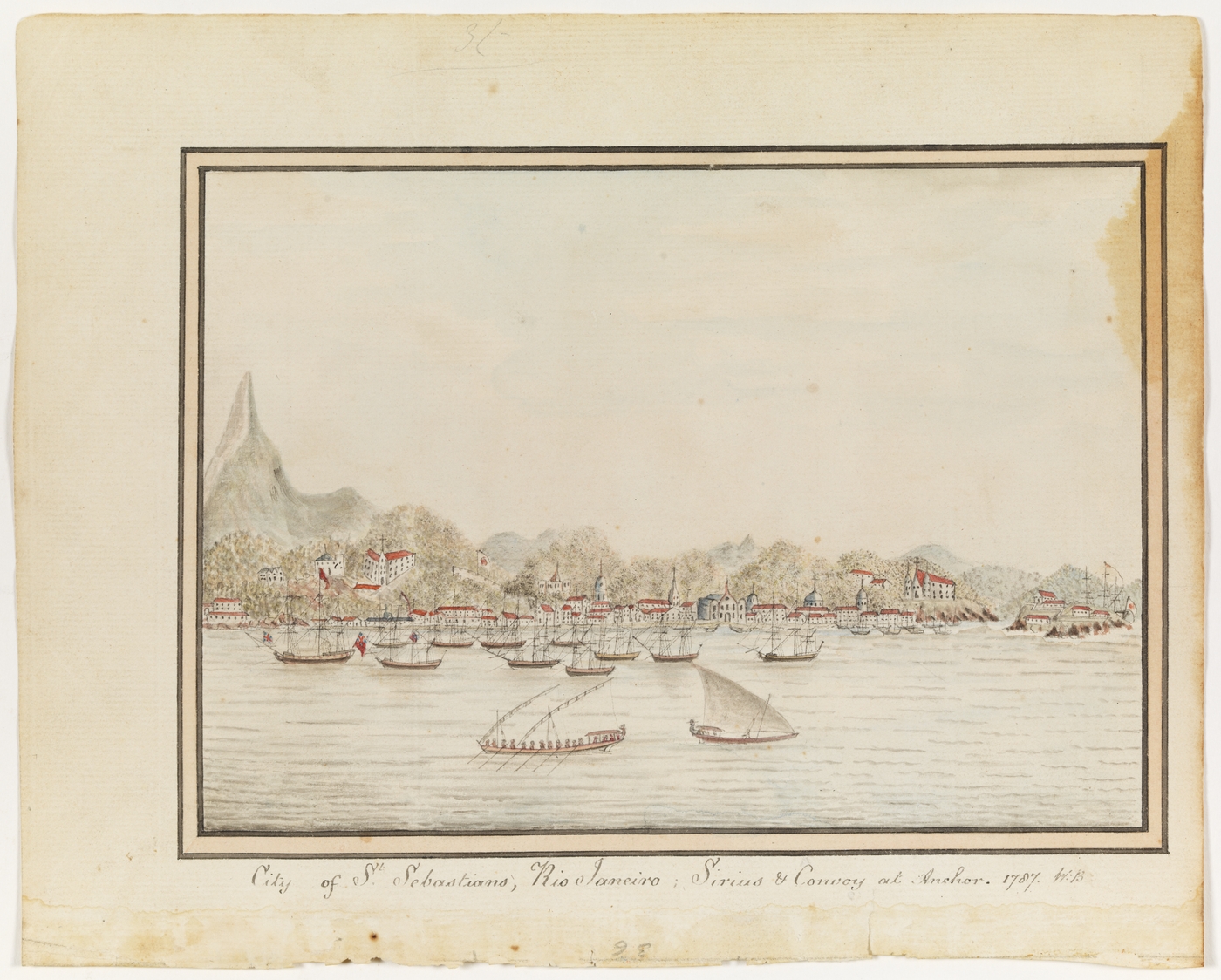The Dictionary of Sydney was archived in 2021.
Fishburn
Citation
Persistent URL for this entry
To cite this entry in text
To cite this entry in a Wikipedia footnote citation
To cite this entry as a Wikipedia External link
Fishburn
At 378 tons, Fishburn was the largest of the three storeships of the First Fleet, the others being Borrowdale and Golden Grove. Fishburn was built in Whitby (as Cook's Endeavour had been) in 1780, and was owned by Leighton & Company, which also owned the other storeships. [1] It is likely Fishburn had been employed as a naval transport between 1780–1784, sailing to and from the Americas. From 1784, she was committed to the coal trade, and in 1785, sailed into London from Newcastle in company with Golden Grove and Borrowdale. [2] Fishburn's master was Captain Robert Brown and the ships log of October 1788 gives a crew number of 17. [3]
In preparation for the voyage to Australia, the three storeships were stocked with a great variety of provisions, ranging from clothing and tools to food and agricultural equipment for the new colony. It was decided to spread the stores among the ships in case of an incident leading to the loss of all of one type of necessity:
Each transport has onboard a certain quantity of each kind of utensils proper for agriculture as well as a distribution of other stores for the use of the colony, so distributed that an accident happening to one ship would not have those disagreeable consequences, which must be the case, if ye whole of one species of stores was onboard each ship. [4]
Prior to departure, a protest over payment by some of the First Fleet seamen affected Fishburn resulting in the desertion of five crewmembers. Four men from HMS Hyaena and one from storeship Golden Grove replaced the missing hands. On 13 May 1787, Fishburn departed Portsmouth, England in company with the other 10 ships of the First Fleet. [5]
[media]From Portsmouth the fleet sailed to Tenerife and Rio de Janeiro before proceeding to Cape Town.
[media]While in Rio, on 25 August, a change to Fishburn's crew took place when captain Robert Brown discharged chief mate James Keltie in order for him to take over as master of HMS Sirius. Illness had forced the master of the Sirius, Micah Morton, to retire from duty. [6]
[media]After departing Cape Town in November, Captain Arthur Phillip sailed ahead with the four fastest ships of the fleet. Fishburn stayed with the second group, which was under the command of John Hunter of HMS Sirius, and anchored with the rest of the fleet in Port Jackson on 26 January 1788. [7]
By July 1788 preparations were well underway for the discharge from government service and return voyage of the storeships Fishburn and Golden Grove. Their departure was delayed by the construction of a spirits storehouse for Fishburn, and by the use of Golden Grove to take provisions and people to the small settlement at Norfolk Island in early October. [8]
Golden Grove returned to Sydney Cove from Norfolk Island on 10 November, bringing replacement masts for herself and Fishburn in preparation for their homeward journey.
Homeward bound
The two storeships departed Sydney Cove for England on 19 November, carrying with them dispatches from Governor Phillip. Phillip was strongly against them taking the route around Cape Horn to Rio de Janeiro, however as with Prince of Wales and Borrowdale, the masters of Fishburn and Golden Grove decided upon this passage.
With their departure, and that of HMS Sirius in early October to fetch much-needed supplies from Cape Town, only HMS Supply remained at the colony.
Fishburn and Golden Grove passed Cape Horn around 10 January, reaching the Falkland Islands on 16 January. The two-week stay in the Falklands, where they could eat fresh food, greatly assisted the recovery of those members of the crew suffering from scurvy. [9]
The vessels left the Falklands on 3 February, remaining in company until 11 April 1789 when Fishburn lost sight of Golden Grove. [10] The two storeships continued their voyages separately from this point. The return voyage of Fishburn and Golden Grove took six months and was the fastest of the returning First Fleet ships.
Fishburn arrived off the Isle of Wight, delivering her dispatches on 12 May. After arriving at Deptford, England, Fishburn was discharged from service on 25 May 1789. Fishburn was lost in a storm off Gun Fleet Sand in October 1789. [11]
References
Cavanagh, AK. 'The Return of the First Fleet Ships'. Victoria: Australian Association for Maritime History, 1989.
Gillen, Mollie. The Founders of Australia: A Biographical Dictionary of The First Fleet. Sydney: Library of Australian History, 1989.
Bateson, Charles. The Convict Ships, 1787–1868. Glasgow: Brown, Son & Ferguson, 1969.
Mundle, Rob. The First Fleet. Sydney: Harper Collins, 2014.
Notes
[1] Charles Bateson, The Convict Ships, 1787–1868 (Glasgow: Brown, Son & Ferguson, 1969), 95
[2] Hampshire Chronicle, 14 August 1780, 2; Lloyds Evening Post, 27–29 September 1780; Caledonian Mercury, 27 September 1780, 3; Hampshire Chronicle, 10 September 1781, 2; Morning Herald and Daily Advertiser, 29 January 1784; Public Advertiser, 18 June 1784; London Chronicle, 19–22 March 1785; Public Advertiser, 25 May 1785; Whitehall Evening Post, 8–10 November 1785; Newcastle Courant, 10 December 1785, 4; Hampshire Chronicle, 28 August 1786, 2
[3] See Log of the Fishburn, UK National Archives ADM51/4375.
[4] PG King, Journal of Philip Gidley King, 1787–1790: Lieutenant, R. N. 1787–1790 (Sydney: University of Sydney Library), Australian Digital Collections/First Fleet and Early Settlement, http://purl.library.usyd.edu.au/setis/id/kinjour, viewed 10 January 2015
[5] Rob Mundle, The First Fleet (Sydney: Harper Collins, 2014), 82
[6] Jonathan King, The First Fleet: The Convict Voyage that Founded Australia 1787–88, (Melbourne: Macmillan, 1982), 85
[7] David Collins, An Account of the English Colony in New South Wales; With Remarks on the Dispositions, Customs, Manners &c. of the Native Inhabitants of that Country, Vol. III, 1798, edited by H Fletcher (Sydney: AH & AW Reed in association with the Royal Australian Historical Society, 1975), 10
[8] AK Cavanagh, The Return of the First Fleet Ships (Victoria: Australian Association for Maritime History, 1989), 6
[9] AK Cavanagh, The Return of the First Fleet Ships (Victoria: Australian Association for Maritime History, 1989), 6
[10] AK Cavanagh, The Return of the First Fleet Ships (Victoria: Australian Association for Maritime History, 1989), 6
[11] Newcastle Courant, 17 October 1789, 4; Navigation Pass No 3456, 13 November 1786, TNA ADM7/104





